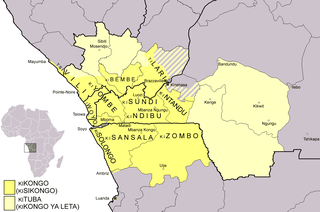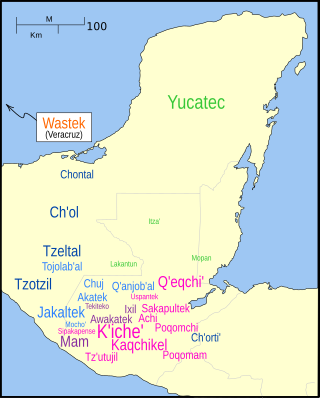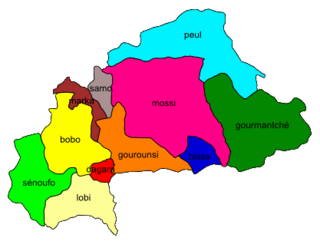Related Research Articles
In linguistics, aspect is a grammatical category that expresses how an action, event, or state, as denoted by a verb, extends over time. Perfective aspect is used in referring to an event conceived as bounded and unitary, without reference to any flow of time during. Imperfective aspect is used for situations conceived as existing continuously or repetitively as time flows.

The Bemba language, ChiBemba, is a Bantu language spoken primarily in north-eastern Zambia by the Bemba people and as a lingua franca by about 18 related ethnic groups.

Kongo or Kikongo is one of the Bantu languages spoken by the Kongo people living in the Democratic Republic of the Congo, the Republic of the Congo, Gabon and Angola. It is a tonal language. It was spoken by many of those who were taken from the region and sold as slaves in the Americas. For this reason, while Kongo still is spoken in the above-mentioned countries, creolized forms of the language are found in ritual speech of Afro-American religions, especially in Brazil, Cuba, Puerto Rico, the Dominican Republic and Haiti. It is also one of the sources of the Gullah language and the Palenquero creole in Colombia. The vast majority of present-day speakers live in Africa. There are roughly seven million native speakers of Kongo, with perhaps two million more who use it as a second language.

Tzeltal or Tseltal is a Mayan language spoken in the Mexican state of Chiapas, mostly in the municipalities of Ocosingo, Altamirano, Huixtán, Tenejapa, Yajalón, Chanal, Sitalá, Amatenango del Valle, Socoltenango, Las Rosas, Chilón, San Juan Cancuc, San Cristóbal de las Casas and Oxchuc. Tzeltal is one of many Mayan languages spoken near this eastern region of Chiapas, including Tzotzil, Chʼol, and Tojolabʼal, among others. There is also a small Tzeltal diaspora in other parts of Mexico and the United States, primarily as a result of unfavorable economic conditions in Chiapas.

Tzotzil is a Maya language spoken by the indigenous Tzotzil Maya people in the Mexican state of Chiapas. Most speakers are bilingual in Spanish as a second language. In Central Chiapas, some primary schools and a secondary school are taught in Tzotzil. Tzeltal is the most closely related language to Tzotzil and together they form a Tzeltalan sub-branch of the Mayan language family. Tzeltal, Tzotzil and Chʼol are the most widely spoken languages in Chiapas besides Spanish.
Taba is a Malayo-Polynesian language of the South Halmahera–West New Guinea group. It is spoken mostly on the islands of Makian, Kayoa and southern Halmahera in North Maluku province of Indonesia by about 20,000 people.
Yakkha is a language spoken in parts of Nepal, Darjeeling district and Sikkim. The Yakkha-speaking villages are located to the East of the Arun river, in the southern part of the Sankhuwasabha district and in the northern part of the Dhankuta district of Nepal. About 14,000 people still speak the language, out of 17,003 ethnic Yakkha in Nepal. Genealogically, Yakkha belongs to the Eastern Kiranti languages and is in one subgroup with several Limbu languages, e.g. Belhare, Athpare, Chintang and Chulung. Ethnically however, the Yakkha people perceive themselves as distinct from the other Kiranti groups such as Limbu.
Manam is a Kairiru–Manam language spoken mainly on the volcanic Manam Island, northeast of New Guinea.
Kituba is a widely used lingua franca in Central Africa. It is a creole language based on Kikongo, a Bantu language. It is a national language in Republic of the Congo and Democratic Republic of the Congo.
Apma is the language of central Pentecost island in Vanuatu. Apma is an Oceanic language. Within Vanuatu it sits between North Vanuatu and Central Vanuatu languages, and combines features of both groups.

Dagaare is the language of the Dagaaba people of Ghana, Burkina Faso, and Ivory Coast. It has been described as a dialect continuum that also includes Waale and Birifor. Dagaare language varies in dialect stemming from other family languages including: Dagbane, Waale, Mabia, Gurene, Mampruli, Kusaal, Buli, Niger-Congo, and many other sub languages resulting in around 3 million Dagaare speakers. Throughout the regions of native Dagaare speakers the dialect comes from Northern, Central, Western, and Southern areas referring to the language differently. Burkina Faso refers to Dagaare as Dagara and Birifor to natives in the Republic of Côte d’Ivoire. The native tongue is still universally known as Dagaare. Amongst the different dialects, the standard for Dagaare is derived from the Central region’s dialect. Southern Dagaare also stems from the Dagaare language and is known to be commonly spoken in Wa and Kaleo.
Lamba is a language found in Zambia and is commonly spoken in the Copperbelt. There are about 210,000 native speakers in the northern parts of Zambia and southern fringes of the Democratic Republic of the Congo. Lamba is also spoken in Lusaka, mainly because many speakers have migrated there for jobs. Lamba is a Bantu language. Depending on who does the counting, Zambia has between 42 and 78 local languages besides English – see Languages of Zambia for further details.
Chokwe is a Bantu language spoken by the Chokwe people of the Democratic Republic of the Congo, Angola and Zambia. It is recognised as a national language of Angola, where half a million people were estimated to have spoken it in 1991; another half a million speakers lived in the Congo in 1990, and some 20,000 in Zambia in 2010. It is used as a lingua franca in eastern Angola.

Njebi is a Bantu language spoken in Gabon and the Republic of Congo.
Kare is a southern Mbum language of the Central African Republic, spoken by the Kare people in the mountains of the northeasterly Ouham-Pendé prefecture around Bocaranga. It is spoken by around 97,000 people in the country, and another few thousand speakers in Cameroon. The language's presence on the southeastern edge of the Mbum family is thought to reflect early 19th-century migrations from the Adamawa Plateau, fleeing Fulani raids.
Buli, or Kanjaga, is a Gur language of Ghana primarily spoken in the Builsa District, located in the Upper East Region of the country. It is an SVO language and has 200 000 speakers.
Ila (Chiila) is a language of Zambia. Maho (2009) lists Lundwe (Shukulumbwe) and Sala as distinct languages most closely related to Ila. Ila is one of the languages of the Earth included on the Voyager Golden Record.
In linguistics and grammar, affirmation and negation are ways in which grammar encodes positive and negative polarity into verb phrases, clauses, or other utterances. An affirmative (positive) form is used to express the validity or truth of a basic assertion, while a negative form expresses its falsity. For example, the affirmative sentence "Jane is here" asserts that it is true that Jane is currently located near the speaker. Conversely, the negative sentence "Jane is not here" asserts that it is not true that Jane is currently located near the speaker.
Neverver (Nevwervwer), also known as Lingarak, is an Oceanic language. Neverver is spoken in Malampa Province, in central Malekula, Vanuatu. The names of the villages on Malekula Island where Neverver is spoken are Lingarakh and Limap.
Lala, Nara, or Pokau is an Austronesian language of the central southern coast of the Papuan Peninsula in Papua New Guinea. This language is spoken in the villages of Oloi, Diumana, Ala'ala, Tubu, Kaiau and Vanuamae. A count in 2017 showed there to be about 3000 speakers with a current language status of developing, meaning that the language is in vigorous use, with literature in a standardized form being used by some.
References
- 1 2 Lobala at Ethnologue (25th ed., 2022)

Iboko at Ethnologue (25th ed., 2022)
- 1 2 Jouni Filip Maho, 2009. New Updated Guthrie List Online
- 1 2 Lobala at Ethnologue (18th ed., 2015)
- ↑ Bernd Heine, Derek Nurse, African Languages: An Introduction, p. 206, Cambridge University Press, 2000 ISBN 0521666295.
- ↑ Lindsay J. Whaley, Introduction to Typology: The Unity and Diversity of Language, p. 4, SAGE Publications, 1996 ISBN 1506317855.